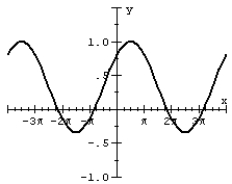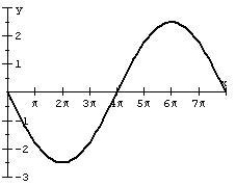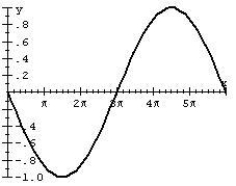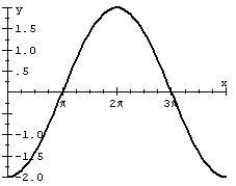Correct Answer

verified
Correct Answer
verified
Multiple Choice
Find the exact value of sec
 Using the unit circle. Rationalize the denominator, if necessary.
Using the unit circle. Rationalize the denominator, if necessary.
A) ![]()
B) ![]()
C) ![]()
D) ![]()
F) B) and C)
Correct Answer

verified
Correct Answer
verified
Short Answer
Sketch the graph of the function
 , over the interval
, over the interval
 .
.
Correct Answer

verified
Correct Answer
verified
Multiple Choice
Use the unit circle to find all the exact values of that make cot =
 In the interval
In the interval

A) ![]()
B) ![]()
C) ![]()
D) ![]()
F) A) and C)
Correct Answer

verified
Correct Answer
verified
Multiple Choice
Match the graph of the sine function to the equation over


A) ![]()
B) ![]()
C) ![]()
D) ![]()
F) A) and C)
Correct Answer

verified
Correct Answer
verified
Short Answer
Find the exact value of cos
 using the unit circle.
using the unit circle.
Correct Answer

verified
Correct Answer
verified
Multiple Choice
Use the unit circle and the fact that the sine is an odd function and the cosine is an even function to find the exact value of sin

A) ![]()
B) ![]()
C) ![]()
D) ![]()
F) B) and C)
Correct Answer

verified
Correct Answer
verified
Short Answer
Use the unit circle and the fact that the sine is an odd function and the cosine is an even function to find the exact value of cos (-300°)
Correct Answer

verified
Correct Answer
verified
Multiple Choice
Find the exact value of tan
 Using the unit circle.
Using the unit circle.
A) ![]()
B) ![]()
C) ![]()
D) ![]()
F) B) and D)
Correct Answer

verified
Correct Answer
verified
Short Answer
Sketch the graph of the function
 ,
,
 .
.
Correct Answer

verified
Correct Answer
verified
Multiple Choice
Find an equation of the graph. 
A) y = ![]()
B) y = ![]()
C) y = ![]()
D) y = ![]()
F) B) and D)
Correct Answer

verified
Correct Answer
verified
Short Answer
Atmospheric Temperature. The average daily temperature in Peoria, Illinois, can be approximated by the equation  where x is the number of days since December 31 of the previous year (Ex: January 1, x = 1; Mar 1, x = 60), and T is in degrees Fahrenheit. What is the expected temperature on July 4th, assuming it is not a leap year? Round your answer to one decimal place.
where x is the number of days since December 31 of the previous year (Ex: January 1, x = 1; Mar 1, x = 60), and T is in degrees Fahrenheit. What is the expected temperature on July 4th, assuming it is not a leap year? Round your answer to one decimal place.
Correct Answer

verified
Correct Answer
verified
Multiple Choice
State the amplitude, period, and phase shift of the function.
Y =

A) ![]()
B) ![]()
C) ![]()
D) ![]()
F) All of the above
Correct Answer

verified
Correct Answer
verified
Short Answer
Find an equation of the graph.

Correct Answer

verified
Correct Answer
verified
Multiple Choice
A weight hanging on a spring will oscillate up and down about its equilibrium position after it's pulled down and released. This is an example of simple hormonic motion. This motion would continue forever if there wasn't any friction or air resistance. Simple harmonic motion can be described with the function
 Where A is the amplitude, t is the time in seconds, m is the mass and k is a constant particular to that spring. If a spring is measured in centimeters and the weight in grams, then what are the amplitude and mass if
Where A is the amplitude, t is the time in seconds, m is the mass and k is a constant particular to that spring. If a spring is measured in centimeters and the weight in grams, then what are the amplitude and mass if
 Amplitude: _____cm.
Mass: ______ g.
Amplitude: _____cm.
Mass: ______ g.
A) Amplitude: 5.5 cm.; mass:g. ![]()
B) Amplitude: 5.5 cm.; mass:g. ![]()
C) Amplitude: 30.25 cm.; mass:g. ![]()
D) Amplitude: 30.25 cm.; mass: 77.44 g.
F) A) and D)
Correct Answer

verified
Correct Answer
verified
Short Answer
Sketch the graph of the function
 ,
,
 .
.
Correct Answer

verified
Correct Answer
verified
Short Answer
State the domain and range of the function. y = -7 sec (4 x) Domain = __________ Range = ___________
Correct Answer

verified
Domain = all real nu...View Answer
Show Answer
Correct Answer
verified
View Answer
Short Answer
Find an equation of the graph.

Correct Answer

verified
Correct Answer
verified
Multiple Choice
Use the unit circle and the fact that the sine is an odd function and the cosine is an even function to find the exact value of cos

A) ![]()
B) ![]()
C) ![]()
D) ![]()
F) A) and C)
Correct Answer

verified
Correct Answer
verified
Multiple Choice
Select the answer that cannot be the value of cot

A) 0.5
B) 39.31
C) 2.23
D) All are possible values of cot. ![]()
F) A) and B)
Correct Answer

verified
Correct Answer
verified
Showing 121 - 140 of 151
Related Exams